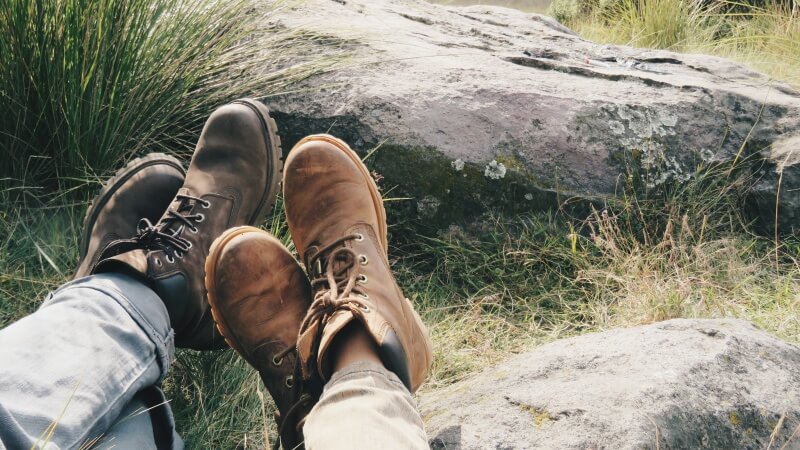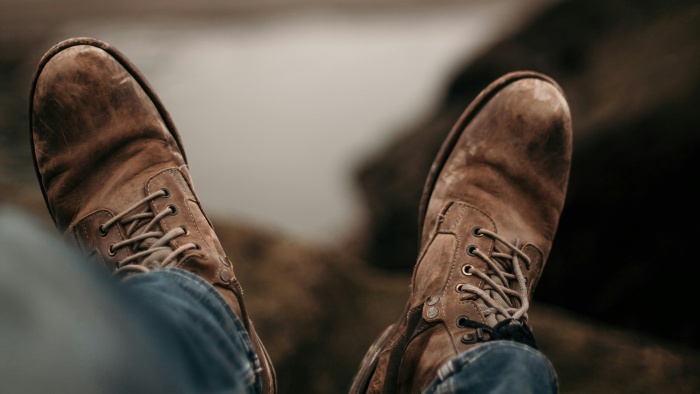Types Of Boots:A Comprehensive Guide

With the myriad types of boots available, it can overwhelm even the most seasoned footwear shopper. Fear not! This ultimate guide is here to navigate you through the selection of the perfect boot for your needs.
We’re honing in on various outdoor and work boots, rather than every boot style known to man. Join us on an exhilarating journey through the world of boots – from the sturdy charm of work and combat boots to the classic beauty of western boots and wedge designs.
Boots vary not just in style but in height as well. We’ll explore the realm of both tall and ankle boots. Are you eager to expand your knowledge about different boot types and their specific uses to elevate your boot collection?
Continue reading and get ready to master the art of boot shopping with confidence!
Tracing boot heritage
Delving into the annals of boot history, we find its origins in 15,000 BC, depicted in an ancient painting showing a male figure in skin boots alongside a female in fur boots. These primitive forms were primarily utilitarian, crafted to protect against harsh environmental conditions.
Boots also made an appearance in 2,140 BC, notably in Khnumhotep’s Tomb. A significant boot depiction dates to 1,000 BC, showcasing the Scythians of southern Siberia donning simple leather boots with fur accents. However, the true revolution in boot craftsmanship began around 3,000 BC with the Minoans, who elevated boot-making to an art form, ushering in a period of remarkable design and skilled production.
Initially conceived for safeguarding the feet and legs, boots gradually evolved. They transcended their practical role to become a symbol of fashion and status, with high-quality pairs made from fine materials signifying wealth and position in society. Presently, the diverse spectrum of boots, from the functional work and combat varieties to the classic western and wedge styles, reflects the rich and evolving journey of this esteemed footwear category.
Exploring the type of boots
Curious about the variety of boot styles available? In today’s market, you’ll find an extensive range of boots differentiated by their design, height, and material. These versatile boots easily transition from day-to-day use, perfectly complementing casual looks, to navigating tough outdoor conditions, and even adding a classic touch to formal ensembles.
Let’s dive into the definitive list of boots – an engaging exploration of the most widespread and favored types, each distinguished by its distinct function and charm. We invite you to delve into the details of their functionality and fame, aiding your quest to find the ideal boot for every event!
Work boots is essential
Work boots combine ruggedness, durability, and style, offering the ultimate protection and comfort for performing tasks in any weather. Their evolution over the past decades has led to designs that safeguard the feet and lower legs, typically featuring a robust lug sole for rough terrain. Furthermore, they rank among the most comfortable boots available.
These formidable boots stand as the titans of footwear, indispensable for daily use in challenging occupations across various sectors, thanks to their robust, safety-toe structure. It’s important to note that these hardy allies come in diverse styles and functionalities, each meticulously crafted to meet particular occupational needs. Therefore, when selecting a work boot, examining its specific features is crucial.
Highly coveted among the array are the famed steel-toe boots, offering unrivaled safety for those in perilous work environments. From construction sites to industrial settings, work boots have earned a reputation for unparalleled reliability, endurance, and protection, empowering workers to face any job with confidence and security.
Unveiling cowboy boots
Rooted in practicality, cowboy boots are a distinct type of footwear. Simply slip them on, use them robustly, and they’ll endure for many years. Far from being just casual shoes, their tall shaft and pointed toe give these boots their unique, instantly identifiable look. It’s important to recognize the two traditional styles of cowboy boots:
The classic cowboy boot showcases a higher, slanted riding heel.
Roper boots feature a lower heel, designed for extensive walking.
Combining work boot durability with classic Western flair, Western work boots offer a tough build, reinforced toe areas, and non-slip soles. This fusion makes them perfect for demanding outdoor tasks while maintaining the iconic cowboy boot aesthetic.

Overview of engineer boots
Engineer boots originated as protective gear for workers stoking steam engines during the industrial revolution. They blend the supportive arch and sole typical of work boots with the high, pull-on design of horse riding boots.
Their distinctive feature is the adjustable buckles, particularly a buckled ankle strap, distinguishing them from other pull-on styles. Today, these versatile boots stand as emblems of enduring strength and classic craftsmanship, equally suited for tough work environments and style-conscious ventures.
Insight into hunting boots
In the Northeast, hunting boots are a fundamental part of the outdoor wardrobe. Their classic design includes a hand-sewn mock toe, a robust, traction-enhancing outsole, and a lace-up closure. These boots have transcended their original purpose, becoming a stylish choice for many, even outside of hunting activities.

Guide to hiking boots
Hiking boots are renowned for their robust soles, lace-to-toe fastenings, and heel support, combining functionality with style. Their popularity stems from their alpine capabilities, a feature they continue to excel in.
Insight into combat boots
Combat boots, the time-honored choice of military personnel, prioritize function over form, exemplifying the precedence of utility. Also referred to as “army boots,” they offer an impressive mix of durability, traction, and stability and have found favor among various counterculture movements.
Understanding rain boots
Rain boots, often known as Wellingtons, galoshes, or gumboots, have evolved beyond their classic yellow color and children’s sizes, adopting a plethora of styles for adult wear. Standing out among waterproof footwear, they offer a unique charm, with their tall, rubber construction ensuring dry feet in wet conditions.
Recently, ankle rain boots have also gained popularity. Wellingtons are among the top waterproof boots, making them a prime choice for rainwear.
Snow boots—winter essentials
Snow boots are crucial for winter, designed to keep feet warm and dry in sub-zero conditions with insulating layers. These boots are a go-to for outdoor activities in wet weather, being waterproof and easy to clean, although they are generally heavier and less breathable.
The evolution of trench boots
Originating from World War I, trench boots, also known as officer or army boots, have transitioned from military gear to stylish essentials. Similar to work boots but with a lower profile, they seamlessly fit into various outfits, making them versatile for different work or weather scenarios.
Moc Toe boots unveiled
Moc toe boots, distinct from other styles, feature visible stitching around their rounded toes, akin to moccasins. Popular with hunters, farmers, and outdoor workers, these boots have tall shafts and rubber soles.
Wedge boots explained
Wedge boots, named for their wedge-shaped sole, vary from work boots to casual and fashionable styles. Their design adds height and style without sacrificing comfort, as the wedge heel runs from the back to the front of the boot, offering stability and support.
Delving into harness boots
Known widely as “biker boots,” harness boots are a top pick among motorcyclists. They are crafted from heavy-duty, resilient leather and vary in height from 10 to 38 inches. The defining characteristic of these boots is the ankle strap linked with a ring, forming the notable harness that gives the boot both its name and unique appeal.
The charm of Chelsea boots
Originating in mid-19th century England, Chelsea boots epitomize classic elegance and sleek style. Recognized for their streamlined design, marked by heel pull-tabs and elastic side panels, these boots are perfect for effortlessly moving from casual to formal settings.
Whether navigating urban landscapes or lighting up the dance floor, Chelsea boots are your go-to for a polished look and assured stride.
Understanding Chukka boots
Chukka boots, also known as desert boots, trace their roots back to British soldiers in Africa during World War II. They later gained popularity in America, becoming a casual wardrobe essential in the latter half of the 20th century. These boots lace up just above the ankle and typically have a soft rubber crepe sole. While available in various styles, the suede version remains a perennial favorite.
Boot styles by height classification
Boots come in various heights, generally fitting into one of these four categories:
- Ankle boots: These are the shortest style in this classification. Ankle boots can end just below, at, or slightly above the ankle. This category encompasses a range of styles, including the timeless chukka and Chelsea boots, and they are versatile enough to be styled as dress boots.
- Calf boots: Many boots are designed to reach calf height, with cowboy and combat boots being notable examples in this category.
- Knee boots: Standing tall, knee-high boots are often considered fashionable and suitable for formal wear, but they also serve functional purposes. Wellington boots are one of the most renowned types of knee-high boots.
- Over-the-thigh boots: Representing the tallest group, over-the-thigh or thigh-high boots are the most extended style among these four. The most extreme version in this category is waders, some of which extend up to the waist or even the chest.
Boot materials and their characteristics
Over time, boots have been crafted from a myriad of materials, including leather, rubber, and nylon, with soles made of diverse substances like cork, rope, and vulcanized rubber. Each material brings unique properties to the table.
Leather boots
Leather, the original boot-making material, remains a popular choice for its style, durability, and ease of cleaning. It’s been a favored material for millennia, primarily used for boot uppers and sometimes soles. Genuine leather is prized for its natural strength and longevity, offering benefits across work, outdoor, fashion, and protective footwear. It’s important, however, to differentiate real leather from imitation variants for the best quality.

Nylon boots
Nylon, known for being lightweight and breathable, is ideal for boots requiring these features. Its durability and color adaptability make it suitable for everything from urban to hiking boots, with common usage in sneaker and military boots.
Polyurethane boots
Polyurethane (PU) stands out for its durability and versatility, often used in colored variants. A key application is in shock-absorbing midsoles, particularly in work boots designed to alleviate plantar fasciitis discomfort.
Rubber boots
Rubber’s strength lies in its durability, waterproofness, and chemical resistance. Its flexibility makes it an excellent material for waterproof boots, forming both uppers and slip-resistant soles.
Suede boots
Suede, a soft and velvety leather, is chosen for its aesthetic appeal and durability. Brown suede is a popular choice for various boot types.
Fleece boots
Fleece, a soft, synthetic, insulating fabric, is a vegan-friendly alternative to wool. It’s primarily used in snow boots for its warmth.
Patent leather boots
Patent leather, recognized for its stiff, shiny, and smooth texture, is treated with varnish for a glossy finish. Offering water resistance and style, it’s been in use since the early 19th century.
Wool boots
Wool, derived from sheep hair, is warm and insulating, making it ideal for winter boots. It’s used for both uppers and linings, enhancing boots’ cold-weather capabilities.
Guidelines for choosing the right boots
When selecting your next favorite pair of boots, consider these key factors:
- Quality and Price: Although higher cost doesn’t always equate to better quality, there’s often a correlation between price and quality in boots. Opting for a cheaper alternative might lead to more frequent replacements. Investing in a durable, high-quality pair is not only cost-effective in the long run but also supports sustainability.
- Comfort: This is crucial, especially if you’ll be wearing your boots regularly or for work. A comfortable pair can make a significant difference in your daily activities.
- Material Considerations: Leather is a top choice for boots due to its durability, comfort, and water resistance. However, it may not be the best option for certain activities, like fishing. Therefore, consider the boot’s intended use, required breathability, and flexibility when choosing the material. This will guide you in selecting the most suitable material for your boots.
- Seasonal Appropriateness: Boots ideal for winter might not be suitable for summer. While all-season boots exist, having specific pairs for each season ensures maximum comfort, as they’re designed with particular weather conditions in mind.
Proper cleaning and storage of boots
To maintain your boots in top condition, following proper cleaning and storage methods is essential, complementing the guidelines previously discussed:
Cleaning Tips:
- Leather Boots: Clean leather boots with a soft brush or damp cloth. For stubborn dirt, use a leather cleaner. Condition them regularly to prevent drying and cracking.
- Suede Boots: Use a suede brush to gently remove dirt. For stains, a suede eraser or a small amount of white vinegar on a cloth can be effective. Avoid water as it can damage suede.
- Nylon and Fabric Boots: These can often be cleaned with mild soap and water. For tougher stains, specialized fabric cleaners are recommended.
- Rubber Boots: Wipe down with soapy water and a sponge. For white residue or blooming, use a rubber boot buffer or olive oil on a cloth.
- Fleece and Wool Boots: Spot clean with a damp cloth and mild detergent. Air dry away from direct heat.
Storage Solutions:
- Avoid storing boots in damp or humid areas to prevent mold and mildew.
- Use boot trees or stuff boots with newspaper to maintain their shape.
- For leather and suede boots, store them in a breathable bag or box to protect them from dust and sunlight.
- If storing boots for an extended period, clean and condition them beforehand, especially leather boots.
- Keep boots away from direct heat sources and sunlight to prevent fading and drying out.
Conclusion
Understanding the nuances of different types of boots, from their design and material to their specific uses, empowers you to make informed choices that cater to both your style and functional needs.
Whether it’s the rugged reliability of work boots, the elegant charm of Chelsea boots, or the specialized design of snow boots, each type offers unique benefits.
Remember, the key to enhancing your footwear collection lies in recognizing the right type of boot for each occasion, environment, and personal preference.
With this knowledge in hand, you’re now equipped to navigate the vast array of boots with confidence and discernment, ensuring that your next pair of boots is not only a stylish addition to your wardrobe but also a testament to informed, quality-focused decision-making.

